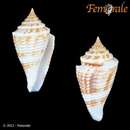fi
nimet breadcrumb-navigoinnissa


Conasprella ist der Name einer Gattung von Schnecken aus der Familie der Kegelschnecken, deren rund 150 Arten in warmen Gewässern des westlichen Atlantischen Ozeans und Karibischen Meers sowie im Indopazifik verbreitet sind und die sich von Vielborstern ernähren.
Die Kegelschnecken der Gattung Conasprella haben einen mehrgewindigen Protoconch mit zweieinhalb Umgängen. Das Schneckenhaus ist kegelförmig, das kegelförmige Gewinde erhaben, und die frühen Umgänge tragen an der Peripherie Knötchen. Der Körperumgang ist in regelmäßigen Abständen mit Schnüren oder Furchen überzogen, die sich von der Mitte bis zur Schulter erstrecken, und auch oben auf den Umgängen des Gewindes können Schnüre verlaufen. Es gibt keine Siphonalkerbe, und die Analkerbe ist tief. Das Periostracum ist glatt, das Operculum klein.
Die mit einer Giftdrüse verbundenen Radulazähne haben eine kurze Schneide, die ein Drittel des Vorderteils des Zahns einnimmt. Es gibt keine hintere Schneide, doch gibt es an der Basis einen Sporn, und der Widerhaken ist kurz. Eine Falte am Schaft und eine innere, hintere Falte sind vorhanden, wenn auch die Falte am Schaft nur schwer zu erkennen ist.
Die Kegelschnecken der Gattung Conasprella sind in tropischen Gewässern sämtlicher Weltmeere ohne den Ostatlantik, also sowohl im Indopazifik mit dem Indischen Ozean und dem westlichen Pazifischen Ozean wie im östlichen Pazifischen Ozean als auch im westlichen Atlantischen Ozean mit dem Karibischen Meer verbreitet.
Aus der Form der Giftzähne an der Radula im Vergleich zu anderen Kegelschnecken beziehungsweise Pfeilzünglern, bei denen diese Zähne dem Stechen und Vergiften der Beutetiere dienen, wird geschlossen, dass sämtliche bekannten Arten der Gattung Conasprella generell Vielborster (Polychaeta) erbeuten. Dokumentiert für zwei karibische Arten ist, dass Conasprella jaspidea große Feuerborstenwürmer frisst[1] und dass sich Conasprella puncticulata von kleinen Vielborstern ernährt.[2] In den Mägen des Centurionen-Kegels (Conasprella centurio) wurden dagegen Reste sowohl von Eichelwürmern als auch von Schnecken gefunden.[3]
Zur Gattung Conasprella werden folgende 149 Arten gezählt:
Conasprella ist der Name einer Gattung von Schnecken aus der Familie der Kegelschnecken, deren rund 150 Arten in warmen Gewässern des westlichen Atlantischen Ozeans und Karibischen Meers sowie im Indopazifik verbreitet sind und die sich von Vielborstern ernähren.
Fusiconus is a subgenus of sea snails, marine gastropod mollusks in the genus Conasprella, family Conidae, the cone snails and their allies.[1]
In the new classification of the family Conidae by Puillandre N., Duda T.F., Meyer C., Olivera B.M. & Bouchet P. (2015), Fusiconus has become a subgenus of Conasprella: Conasprella (Fusiconus) Tucker & Tenorio, 2009 represented as Conasprella Thiele, 1929 [2]
The Tucker & Tenorio 2009 taxonomy distinguishes Fusiconus from Conus in the following ways:[3]
This list of species is based on the information in the World Register of Marine Species (WoRMS) list. Species within the genus Fusiconus include:[1]
Prior to 2009, all cone species were placed within the family Conidae and were placed in one genus, Conus. In 2009 however, J.K. Tucker and M.J. Tenorio proposed a classification system for the over 600 recognized species that were in the family. Their classification proposed 3 distinct families and 82 genera for the living species of cone snails, including the family Conilithidae. This classification was based upon shell morphology, radular differences, anatomy, physiology, cladistics, with comparisons to molecular (DNA) studies.[3] Published accounts of genera within the Conidae (or Conilithidae) that include the genus Fusiconus include J.K. Tucker & M.J. Tenorio (2009), and Bouchet et al. (2011).[4]
Testing in order to try to understand the molecular phylogeny of the Conidae was initially begun by Christopher Meyer and Alan Kohn,[5] and is continuing, particularly with the advent of nuclear DNA testing in addition to mDNA testing.
However, in 2011, some experts still use the traditional classification, where all species are placed in Conus within the single family Conidae: for example, according to the current November 2011 version of the World Register of Marine Species, all species within the family Conidae are in the genus Conus. The binomial names of species in the 82 cone snail genera listed in Tucker & Tenorio 2009 are recognized by the World Register of Marine Species as "alternative representations."[6] Debate within the scientific community regarding continues, and additional molecular phylogeny studies are being carried out in an attempt to clarify the issue.[3][7][8][9][10][11][12][13][14][15][16][17][18][19][20][21]
All this has been superseded in 2015 by the new classification of the Conidae [2]
Fusiconus is a subgenus of sea snails, marine gastropod mollusks in the genus Conasprella, family Conidae, the cone snails and their allies.
In the new classification of the family Conidae by Puillandre N., Duda T.F., Meyer C., Olivera B.M. & Bouchet P. (2015), Fusiconus has become a subgenus of Conasprella: Conasprella (Fusiconus) Tucker & Tenorio, 2009 represented as Conasprella Thiele, 1929
Fusiconus est un sous-genre du genre Conasprella, des mollusques gastéropodes marins de la famille des Conidae.
Selon BioLib (10 octobre 2019)[2]:
Fusiconus est un sous-genre du genre Conasprella, des mollusques gastéropodes marins de la famille des Conidae.
Conasprella is een geslacht van weekdieren uit de klasse van de Gastropoda (slakken).
Conasprella is een geslacht van weekdieren uit de klasse van de Gastropoda (slakken).